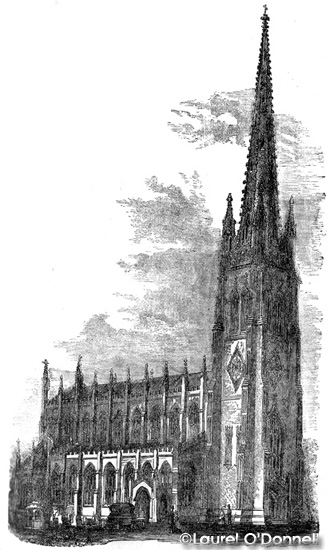|
|
Chapter IV
New York As It Is.
Churches of New York A. Description of the Island.—
B. Population at Different Periods.—
C. Streets and Avenues.—
D. Architecture of Manhattan—
E. Business in New York—
F. Churches of New York—
G. Parks and Squares.—
H. How New York is Supplied with Water.—
I. The Schools and Colleges of New York.—
J. Public Security—
K. New York All the Year Round—
L. The Libraries, Monuments and Markets of New York—
M. The Cemeteries of New York.
Protestant Episcopal
Churches of New York—
Reformed Dutch—
Protestant Episcopal—
Lutheran—
Presbyterian—
Baptist—
Methodist—
Jewish—
Roman Catholic—
Other Denominations and Missionary Societies.
 Trinity Church. Broadway opposite, Wall Street; 80 x 192 feet; 284 feet high. On the surrender of Manhattan to the English in 1664, the haughty conquerors not only took possession of the fort, but of the church also, and forthwith introduced the Episcopal service, changing the name of the building to King's Chapel. The service of the church of England was conducted here until the dedication of the first Trinity in February, 1697. This building, which stood on the site of the present Trinity, was a small, square edifice, and after being twice enlarged, was destroyed by the great conflagration of 1776. It was rebuilt in 1788, pulled down in 1840, and the present magnificent structure completed and opened for worship, May 21st, 1846. It is solid New Jersey brown-stone from foundation to spire, except the roof, which is wood. The edifice, which is in the Gothic order, is 192 feet long and 80 feet wide, the side walls rising fifty feet. The spire stretches upward to the lofty altitude of 284 feet, up the winding stairs of which hundreds ascend daily 308 steps (250 feet) to the tower, where they, obtain a magnificent view of the city, and its immediate surroundings. The chimes of Trinity are surpassed by few bells in the world. Trinity was endowed by Queen Anne, and came into possession of a large farm owned by a Dutch woman named Anneke Jans, which now covers a large portion of the city. Trinity is the mother of Episcopal churches in America. It is the richest religious corporation on the continent, its property, mostly in city real estate, being valued at forty or fifty millions. Many of the streets of New York bear the names of her rectors and vestrymen. The plan of a collegiate charge was early adopted by the Dutch and Episcopal churches of New York, and still continues to a limited extent. St. Paul's, situated on Broadway, between Fulton and Vesey steets, a fine structure of reddish gray-stone; was opened for dedication October 30th, 1766. St. Johns, on Varick street, was erected in 1807, at a cost of over two hundred thousand dollars, and St. George's was dedicated July 1st, 1752. All these were, under the Trinity parish, though the last-named has since become a separate corporation. The Episcopalians of New York are a vigorous and benevolent body, forming really the strength of the denomination in the country, supporting numerous benevolent institutions, and paying annually large sums to maintain feeble parishes, scattered over the interior of the State. Their churches and chapels (94 in all) outnumber those of any other denomination on the island. They have been exceedingly happy in selecting names for their churches; besides the churches of the Holy Apostles, Holy Innocents, Holy Communion, Holy Martyrs, and Holy Trinity, we read of the church of St. Alban's, St. Ambrose, St. Andrew's, St. Ann's, St. Clement, St. John's, St. Luke's, St. Mark's, St. Paul's, St. Peters, St. Philip's, St. Stephen's, St. Mary's, etc., etc., until one feels that New York is a sainted community, notwithstanding the number of sinners reported to still lurk around its corners. |
|
86
:: Previous Page :: Next Page ::
Books & articles appearing here are modified adaptations
from a private collection of vintage books & magazines. Reproduction of these pages is prohibited without written permission. © Laurel O’Donnell, 1996-2006.
|
|
